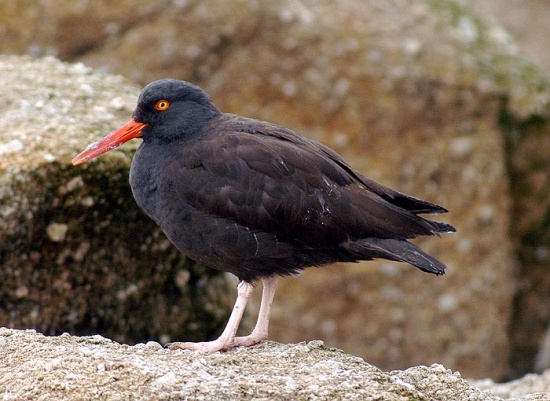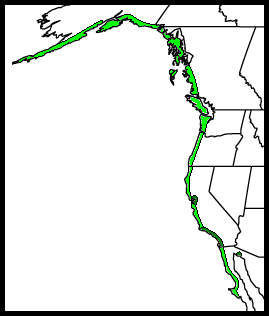| Line 1: | Line 1: | ||
| + | '''Alternative Name: Western Black Oystercatcher''' | ||
[[Image:Black_Oystercatcher.jpg|thumb|550px|right|Photo by '''Doug Greenberg'''<br />Location: Point Pinos, Pacific Grove, [[California]], [[USA]]]] | [[Image:Black_Oystercatcher.jpg|thumb|550px|right|Photo by '''Doug Greenberg'''<br />Location: Point Pinos, Pacific Grove, [[California]], [[USA]]]] | ||
| − | |||
;[[:Category:Haematopus|Haematopus]] bachmani | ;[[:Category:Haematopus|Haematopus]] bachmani | ||
==Identification== | ==Identification== | ||
All black shorebird, 9 cm bright red bill, pink legs, bright yellow iris, red eye-ring. The plumage varies slightly from north to south, being darker further north. | All black shorebird, 9 cm bright red bill, pink legs, bright yellow iris, red eye-ring. The plumage varies slightly from north to south, being darker further north. | ||
| − | |||
==Distribution== | ==Distribution== | ||
{| cellpadding="5" | {| cellpadding="5" | ||
| Line 25: | Line 24: | ||
The nests are small bowls or depressions close to the shore filled with small pebbles and shell fragments. 2-3 eggs are laid and are incubated for around 26-28 days. The chicks are capable of leaving the nest after one day; they stay in the territory for about 40 days after fledging. The fledged juveniles stay in the territory until the next breeding season. If the parents migrate, that year's chicks will migrate with them; this happens more often in the north of the range. | The nests are small bowls or depressions close to the shore filled with small pebbles and shell fragments. 2-3 eggs are laid and are incubated for around 26-28 days. The chicks are capable of leaving the nest after one day; they stay in the territory for about 40 days after fledging. The fledged juveniles stay in the territory until the next breeding season. If the parents migrate, that year's chicks will migrate with them; this happens more often in the north of the range. | ||
| − | |||
| − | |||
| − | |||
==References== | ==References== | ||
| − | # | + | #{{Ref-Sibley00}}#{{Ref-Brinkley07}}# Andres, Brad A., and Gary A. Falxa. 1995. "Black Oystercatcher (Haematopus bachmani)." ''The Birds of North America Online'' (A. Poole, Ed.). Ithaca: Cornell Lab of Ornithology; Retrieved from the Birds of North America Online: http://bna.birds.cornell.edu/bna/species/155. |
| − | # | ||
| − | # Andres, Brad A., and Gary A. Falxa. 1995. "Black Oystercatcher (Haematopus bachmani)." ''The Birds of North America Online'' (A. Poole, Ed.). Ithaca: Cornell Lab of Ornithology; Retrieved from the Birds of North America Online: http://bna.birds.cornell.edu/bna/species/155. | ||
==External Links== | ==External Links== | ||
{{GSearch|Haematopus+bachmani}} | {{GSearch|Haematopus+bachmani}} | ||
[[Category:Birds]][[Category:Haematopus]][[Category:Maps]] | [[Category:Birds]][[Category:Haematopus]][[Category:Maps]] | ||
Revision as of 23:08, 15 November 2008
Alternative Name: Western Black Oystercatcher
- Haematopus bachmani
Identification
All black shorebird, 9 cm bright red bill, pink legs, bright yellow iris, red eye-ring. The plumage varies slightly from north to south, being darker further north.
Distribution
| Western Aleutian Islands, along Canadian, American, and Mexican Pacific coasts to central Baja and Los Coronados Islands. | |
| Legend • H. bachmani; year-round |
Taxonomy
A monotypic species.
Habitat
Rocky shorelines.
Behaviour
The diet includes marine invertebrates, particularly mussels, limpets and chitons, also crabs and barnacles. It uses its strong bill to dislodge food and pry shells open.
The nests are small bowls or depressions close to the shore filled with small pebbles and shell fragments. 2-3 eggs are laid and are incubated for around 26-28 days. The chicks are capable of leaving the nest after one day; they stay in the territory for about 40 days after fledging. The fledged juveniles stay in the territory until the next breeding season. If the parents migrate, that year's chicks will migrate with them; this happens more often in the north of the range.
References
- Sibley, DA. 2000. The Sibley Guide to Birds. New York: Alfred A. Knopf. ISBN 978-0679451228
- Brinkley, ES. 2007. Field Guide to Birds of North America. New York: Sterling Publishing Co., Inc. ISBN 978-1402738746
- Andres, Brad A., and Gary A. Falxa. 1995. "Black Oystercatcher (Haematopus bachmani)." The Birds of North America Online (A. Poole, Ed.). Ithaca: Cornell Lab of Ornithology; Retrieved from the Birds of North America Online: http://bna.birds.cornell.edu/bna/species/155.





